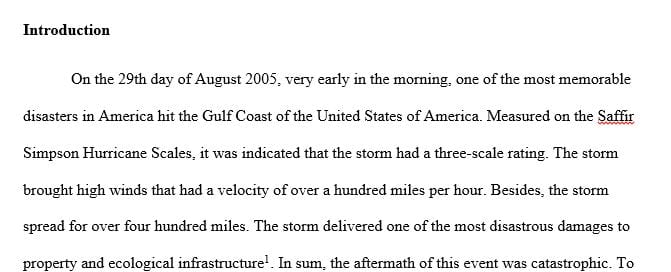How did the local population react and how did they respond
Specifics for Research Paper #1 – divide paper into the following 5 sections…
Introduction – what happened, when, how does it fit within the category of disasters in U. S. history?
How did the local population react and how did they respond?
How did the government react? How did the government respond?
What lessons where learned from this event? What lessons were not followed?
Based on your knowledge of this disaster and others, what are your recommendations for residents living in regions where this type of disaster could happen again?
Potential topics:(If you choose a topic not on this list you need to get approval.)
Hurricane Galveston – Sept. 8, 1900
bustling island community was the hub of the cotton trade and Texas’ largest city.
category 4 hurricane – 135 mph winds
buildings crumbled under the force of 15-foot-high waves.
estimated 8,000 people perished
Hurricane Katrina – Aug. 29, 2005
hit Louisiana coast with 125 mph winds
storm surge broke levees that protected New Orleans from coastal waters
80% of the city under water
killed at least 1,836 people &damages around $125 billion
Dust Bowl – 1930’s (Great Depression era)
before 1930’s Great Plains was a farmer’s paradise
decade-long droughttransformed loose topsoil into dust
windstorms blew eastward, darkening skies as far away as the Atlantic Coast.
a third of the farmers turned to government aid,
while around half a million Americans were left homeless.
Great San Francisco Fire and Earthquake – April 18, 1906
quake unleashed a chain of events that caused the city to burn for 4days
estimated 7.7- to 7.9-magnitude temblor
broke natural gas mains, which sparked the fires, but also damaged water mains,
more than 500 city blocks, and 3,000 deaths &approximately 225,000 homeless
Okeechobee Hurricane – September 16, 1928
residents warned & evacuated but hurricanehadn’t arrived on schedule, many returned home
storm slammed ashore later that night with 140 mph winds
broke a small dike … weeks of heavy flooding claimed 2,500+ lives
Heat Wave of 1980 – Summer of 1980
one of the nation’s most catastrophic prolonged weather events.
above 90 degrees Fahrenheit for most of the summer … central and southern U. S.
$48 billion in agricultural damage tallied an estimated due drought
10,000 people died from heat and heat stress-related ailments
Heat Wave of 1988 – Summer of 1988
total rainfall along the Great Plains lower than during Dust Bowl plus heat wave
$61+ billion damage to agriculture economy
drought resulted in wildfires – Yellowstone National Park& Mount Rushmore
1000s of heat related deaths
Peshtigo Fire – October 8, 1871
Wisconsin fire(nation’s deadliest) – same day as Great Chicago Fire of 1871
drought plus windstorm =fires in Peshtigo & prairie fires – over 1 mil. acres
scorched 12 towns and left roughly 1,200 dead
Tri-State Tornado – March 18, 1925
3 ½ hours across Illinois, Missouri & Indiana – 695 deaths
track of tornado 219 miles (world record)&path from .75 miles to 3 miles wide
estimated F5 category – (Fujita scale not around then) – wind speeds 300+ mph
forecasters looked into developing a tornado warning system
Johnstown Flood – May 31, 1889
late 19th Century, the small steel industrial community
poorly maintained South Fork dam that stood high up in the mountains, 14 miles from the city, failed.
days of torrential downpour– dam to burst … 20+ million tons of water and debris crashed down on city with tremendous force
leveled 1,600 homes and killed 2,209 people
Hurricane Andrew, August 1992
August 24 – made landfall in Homestead, Florida (rains started day before)
Category 5 – one of few to hit land as Cat 5&wind speeds 175 mph
65 deaths … $25 billion damages in Florida alone
worst damage in Florida, Louisiana, and Bahamas
San Francis Dam Disaster , March 12, 1928
San Francisquito Canyon
Construction began March 1925
Catastrophically failed on March 12, 1928
One of the worst civil engineering failures in the 20th century
Northridge Earthquake, January 17, 1992
17, 1994 – 4:30am
7 magnitude
buildings, bridges collapse
fatalities
Fires / Big Bear & Lake Arrowhead, October 2003
started Oct 25, 2003 in Old Waterman Canyon
bark beetle / drought blamed for severe spread of fire
destroyed almost 1000 buildings
burned over 91,000 acres&$42 million cost
Answer preview to how did the local population react and how did they respond
APA
2070 words


